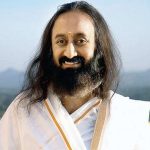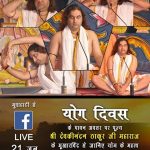History of Yog : Yoga In The Light Of Vedas
Courtesy : http://www.bharatyog.com/

We are providing you with the knowledge of Different Aspects of Yoga, Vedic Yoga, Important Aspects of Yoga, Scientific Aspect of Yoga, Yoga in Vedas, in the absence of which most of us fear of adopting this useful thing and therefore are not able to take the maximum benefit out of it.
The first books to refer to yog are the ancient Vedas. Although they don’t give specific practices, they allude to yog symbolically. The verses of the Vedas were heard by the rishis, seers, in states of deep, yogic meditation or Samadhi, and are regarded as revealed scriptures. In Upanishads Yog begins to take a more definable shape.
According to mythical tradition, Lord Shiv is said to be the founder of yog and goddess Parvati, his first disciple. We get the first glimpse of Yog in Vedas, the oldest scripture and later in Treta Yug we get Yog Vashishta from guru Vashishtha, the guru of Lord Rama. Then in Dwapar Yug we get the real lesson of Yog as SRIMADBHAGVAD GEETA by Yogeshvara Krishna. Finally today in Kalyug Yog is not an unfamiliar name.
Yog arouse at the beginning of human civilisation when man started feeling difference between sorrows and joys. He was in search of permanent remedy to come out of this ocean of sorrows and as an alternative wanted to seek imperishable joy later known as bliss. Indian sages realized their spiritual potential and began to evolve techniques to develop it. The yogic science was evolved and developed by ancient sages all over the world.
In archaeological excavations made in the Indus Valley at Harappa and Mohenjodaro, now in modern Pakistan, many statues have been found depicting deities resembling lord Shiv and Parvati performing various asanas, mudras and meditation. These ruins were once the dwelling place of people who lived in the pre-Vedic age before the Aryan civilisation started to flourish in the Indus sub continent.
In ancient times, Yog techniques were kept secret and were never written down or exposed to public view and were passed on from Guru to disciple by word of mouth as shruti due to which there was a clear understanding of subject, yog sutras and their meaning and aim. Till day, many enlightened gurus believe that knowledge of yoga can never be gained through books. One needs a practical training under the expert guidance of a guru and this is the only reason that many of the ancient and the most effective techniques of Yog are still with the enlightened Gurus and not in any of the book or videos.
In the 6th century BC, Lord Buddha’s influence brought the ideals of meditation to the fore and the preparatory of Yog were ignored. The Indian thinkers soon realized the limitations of this view and Yogi Matsyendra nath taught that before taking to the practices of meditation, the body and its elements need purification. Yogic pose Matsyendrasana was also named after this great master. His chief disciple Guru Gorakhnath wrote books on Hath Yog.
|
Yoga is a science, which deals with the facts. Yog is a therapy to forever remain young fit and happy. Yoga is a lifestyle which touches all the levels of human life, Physical level, mental level, emotional level, intellectual level, Social level, financial level, psychological level and Spiritual level.
Yoga is a science to keep the body fit and prepare the mind for uplift of the spiritual aspects. Yoga works as a strengthening tool for the entire mind and body. Our body is like any other machine which needs proper care, checkups, toning, repair and proper rest. Let’s take the example of the car. Before driving a car we check the petrol, we check the tyres, and we check whether the engine is toned up or not… but unfortunately we never check this machine, this divine gift of God… our body, we wake up in the morning and start taking work from this body without checking its working conditions.
So, if we have proper and guided knowledge of yoga and meditation, Different Aspects of Yoga, Vedic Yoga, Important Aspects of Yoga, Scientific Aspect of Yoga, Yoga in Vedas, we can use it to our maximum and therefore be benefitted.
All of the machines need external forces to keep them work smoothly but we have the power inside this body i.e. the mind + will power + determination + Science of yog to constantly tune up our body.
Yog is not at all a magic, which can cure all of the ailments including cancer and aids. In fact it’s a science which increases the immunity level of the practitioner with continuous practice, it’s a science which is preventive first and later curative, it’s a science which is not a substitute for medication but can make the practitioner stay away from medicines with continuous yog practice.
Effectiveness of yog depends on the regularity and accuracy of the exercises. “Yog is not an ancient myth buried in oblivion. It is the most valuable inheritance of the presence, it is the essential need of today and the culture of tomorrow” says swami Satyanand saraswati ji. Mind control exercises combined with controlled breathing is a vital tool to acclimatize the body and mind.
Yog Guru Bharat Bhushan ji tells “This has been scientifically proved that on an average day an average man have around 70,000 thoughts in his mind and out of these 70,000 thoughts 95% of the thoughts are all same each day… Yog is the only technique, which takes an individual beyond the thoughts. Guru Bharat Bhushan ji adds, “We generally judge others very easily, we wish to control… to master the entire world… but what about knowing ourselves? What about controlling and mastering ourselves? The only technique for self- control and self- mastery is YOG.”
For quality wise improvement in performance, to increase resistance power, mental abilities and for self-mastery, yog has been proved as a great science.













